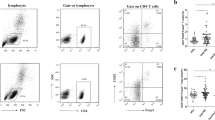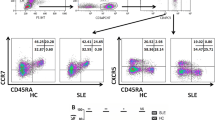Abstract
The aim of this study was to investigate the percentage of regulatory T cells and the correlation with clinical activity in Behçet’s disease. Forty Behçet’s disease (BD) patients, 18 males and 22 females, were included in the study. The patients were diagnosed according to the published BD criteria. Twenty age- and sex-matched volunteer healthy donors were also included. At the time of sampling, clinical activity was assessed for activity signs and symptoms according to the BD Current Activity Form. We considered active those patients with a clinical activity index equal to and/or above 2. Eleven patients had active disease and the remaining were considered as clinically inactive. We have studied the percentages of CD4+CD25+FOXP3+, CD4+CD25+ and CD4+FOXP3+regulatory T cells by flow cytometry and investigated the correlation with disease activity. Percentage of CD4+CD25+FOXP3+Treg in active patients was lower than clinically inactive patients and healthy controls. Percentage of CD4+CD25+Treg was not different between active and inactive patients and healthy controls. Percentage of CD4+FOXP3+Treg was lower than healthy controls in clinically active patients but was not different for inactive group and healthy controls. Patients were active when CD4+CD25+FOXP3+Treg was ≤1.19 %, CD4+CD25+Treg was ≤2.68 %, and CD4+FOXP3+Treg was ≤2.60. CD4+CD25+FOXP3+Treg and CD4+FOXP3+Treg were found negatively correlated with disease activity. Peripheral blood regulatory T cells are decreased in clinically active Behçet’s disease patients. The advances in our understanding of the interactions between distinct subsets of Treg and clinical activity might help in modulating BD treatment.




Similar content being viewed by others
References
Sakane T, Takeno M, Suzuki N, Inaba G (1999) Behçet’s disease. N Engl J Med 341:1284–1291
McGonagle D, McDermott MF (2006) A proposed classification of the immunological diseases. PLos Med 3:1242–1248
Andersson J, Tran DQ, Pesu M, Davidson TS, Ramsey H, O’Shea JJ et al (2008) CD4+FoxP3+regulatory T cells confer infectious tolerance in a TGF-beta-dependent manner. J Exp Med 205:1975–1981
McMurchy AN, Bushell A, Levings MK, Wood KJ (2011) Moving to tolerance: clinical application of T regulatory cells. Sem Immunol 23:304–313
International Study Group for Behçet’s Disease (1990) Criteria for diagnosis of Behçet’s disease. Lancet 335:1078–1080
Bhakta BB, Brennan P, James TE, Chamberlain MA, Noble BA, Silman AJ (1999) Behçet’s disease: evaluation of a new instrument to measure clinical activity. Rheumatology 38:728–733
deChambrun MP, Wechsler B, Geri G, Cacoub P, Saadoun D (2012) New insights into the pathogenesis of Behçet’s disease. Autoimmune Rev 11:687–698
Fontenot JD, Gavin MA, Rudensky AY (2003) Foxp3 programs the development and function of CD4+CD25+regulatory T cells. Nat Immunol 4:304–306
Allan SE, Crome SQ, Crellin NK, Passerini L, Steiner TS, Bacchetta R et al (2007) Activation induced Foxp3 in human T effector cells does not suppress proliferation or cytokine production. Int Immunol 19:345–354
Nanke Y, Kotake S, Goto M, Ujihara H, Matsubara M, Kamatni N (2008) Decreased percentages of regulatory T cells in peripheral blood of patients with Behçet’s disease before ocular attack: a possible predictive marker of ocular attack. Mod Rheumatol 18:354–358
Hamzaoui K, Borhani Haghighi A, Ghorbel IB, Houman H (2011) RORC and Foxp3 axis in cerebrospinal fluid of patients with neuro-Behçet’s disease. J Neuroimmunol 50:249–253
Pekiner FN, Aytugar E, Demirel GY, Borahan MO (2012) Interleukin-2, interleukin-6 and T regulatory cells in peripheral blood of patients with Behçet’s disease and recurrent aphthous ulcerations. J Oral Pathol Med 14:73–79
Hamzaoui K (2007) Paradoxical high regulatory T cell activity in Behçet’s disease. Clin Exp Rheumatol 25:107–113
Hamzaoui K, Hamzaoui A, Houman H (2006) CD4+CD25+regulatory T cells in patients with Behçet’s disease. Clin Exp Rheumatol 24:71–78
Geri G, Terrier B, Rosenzwajg M, Wechsler B, Touzot M, Seilhean D et al (2011) Critical role of IL-21 in modulating T(H)17 and regulatory T cells in Behçet’s disease. J Allergy Clin Immunol 128:655–664
Liang L, Wang H, Peng XY, Zhao M (2011) The changes of Th lymphocyte subsets in patients with Behcet disease. Zhonghua Yan Ke Za Zhi 47:393–397
Mochizuki M, Morita E, Yamamoto S, Yamana S (1997) Characteristics of T cell lines established from skin lesions of Behçet’s disease. J Dermatol Sci 15:9–13
Sugita S, Yamada Y, kaneko S, Horie S, Mochizuki M (2011) Induction of regulatory T cells by infliximab in Behçet’s disease. IOVS 52:476–484
Bluestone JA (2005) Regulatory T cell therapy: is it ready for the clinic? Nat Rev Immunol 5:343–349
Tang Q, Henriksen KJ, Bi M, Finger EB, Szot G, Ye J et al (2004) In vitro expanded antigen specific regulatory T cells suppress autoimmune diabetes. J Exp Med 199:1455–1465
Furtado GC, Olivares-Villagomez D, Curotto de Lafaille MA, Wensky AK, Latkowski JA, Lafaille JJ (2001) Regulatory T cells in spontaneous autoimmune encephalomyelitis. Immunol Rev 182:122–134
Shim J, Lee ES, Park S, Bang D, Sohn S (2011) CD4+CD25+regulatory T cells ameliorate Behçet’s disease like symptoms in a Mouse model. Cytotherapy 13:835–847
Author information
Authors and Affiliations
Corresponding author
Rights and permissions
About this article
Cite this article
Gündüz, E., Teke, H.Ü., Bilge, N.Ş.Y. et al. Regulatory T cells in Behçet’s disease: Is there a correlation with disease activity? Does regulatory T cell type matter?. Rheumatol Int 33, 3049–3054 (2013). https://doi.org/10.1007/s00296-013-2835-8
Received:
Accepted:
Published:
Issue Date:
DOI: https://doi.org/10.1007/s00296-013-2835-8




